Calling all imagers! Three comets will make close flybys of Earth over the next two years. Join a new pro-am effort to make the most of this rare triple play.
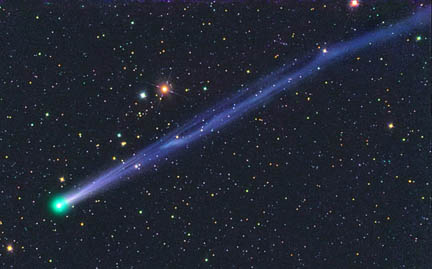
Michael Jaeger
If you're as crazy about comets as I am, here's an opportunity to make an important contribution to their understanding. The Planetary Science Institute (PSI) is putting out the call to amateurs and professionals alike to make the best of a unique opportunity.
The Planetary Science Institute is a private, nonprofit corporation dedicated to solar system exploration. It's headquartered in Tucson, Arizona, where it was founded in 1972. PSI scientists and educators are involved in everything from space missions to solar system studies, science education, and public outreach.
Three comets — 41P/Tuttle-Giacobini-Kresak, 45P/Honda-Mrkos-Pajdusakova, and 46P/Wirtanen — will all pass Earth at very close distances ranging from 7.4 million to 14 million miles (11.9 to 22.5 million km) within the next two years. Close approaches of three comets within two years are rare and only happen every few decades.
“We are organizing a worldwide coma morphology campaign for three comets,” said Nalin Samarasinha, senior scientist at PSI, who is leading the project. “Two of these comets will have close approaches to Earth in early 2017, while the third one will come close in late 2018. We want to get both professional and amateur astronomers involved in the campaign.”
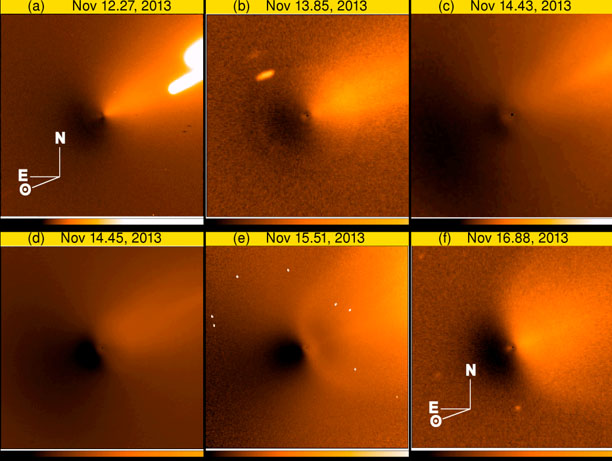
Samarasinha et al. 2015, Planetary and Space Science, 118, 127-137
The new push, modeled after their Comet ISON (C/2012 S1) effort from several years back, is called the 4*P Coma Morphology Campaign. It seeks detailed images of each comet's coma from locations spread across the globe to ensure continuous monitoring of fast-changing activity near the nucleus. The comets are expected to be most active when within 1.5 astronomical units of the Sun.
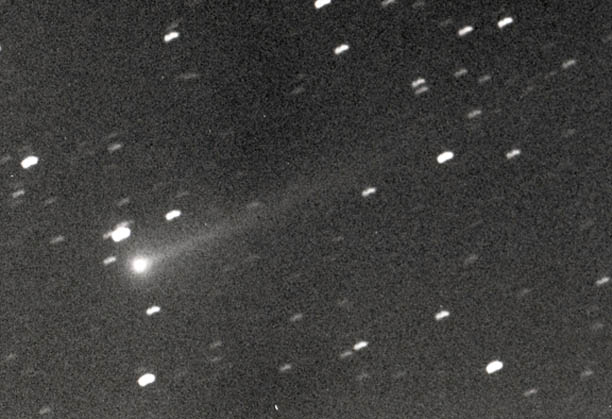
Michael Jaeger
You can submit photos taken in regular light showing dust features or taken through narrowband filters that enhance a comet's gaseous emissions. PSI suggests the best time to obtain images will be from about mid-February through mid-March 2017 for 45P/H-M-P and the end of January through July 2017 for 41P/T-G-K. Because it's still far off, the Institute will specify the best times for 46P/Wirtanen in 2018.
Through the pro-am effort, astronomers hope to determine key characteristics about each of the three comets: the rotation rate of the nucleus, the onset and evolution of any outbursts or fragmentation events, as well as changes in coma and tail structure. If your photo is used in the study, you'll receive mention as a co-author.
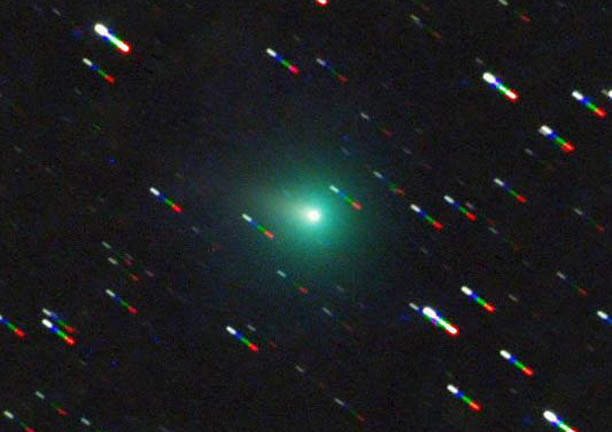
Rolando Ligustri
Another group, the PACA Project (Pro-Am Collaborative Astronomy), is also getting into the act and welcomes not only photos of small and large scale phenomena but visual observations. Padma A. Yanamandra-Fisher, a senior research scientist at the Space Science Institute and founder of the project, extends an invitation:
"The PACA Project has launched two new professional-amateur observing campaigns and invites observers of all expertise to join and share the thrill of observing comets." Interested observers should send requests to join Facebook groups PACA_4145P and PACA_46_Wirtanen at the link above.
While the PSI campaign seeks only near-nucleus coma images, visual observers can still join the fun by finding and following all three comets from their faint beginnings to what we hope will be bright and satisfying apparitions. The charts below will get you off and running.
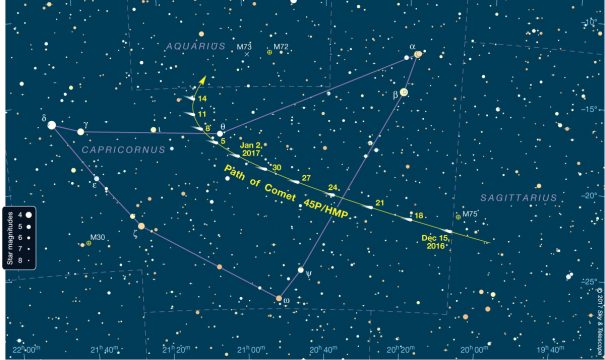
Sky & Telescope diagram
First up is Comet 45P/H-M-P, currently around magnitude +14 but expected to brighten rapidly in the coming weeks. Watch for it to reach +7 in early January and perhaps even magnitude +6, when it passes just 7.4 million miles (11.9 million km) from Earth in mid-February. While bright, the comet will be fairly large and diffuse and located low in the southwestern early evening sky for observers at mid-northern latitudes through mid-January.
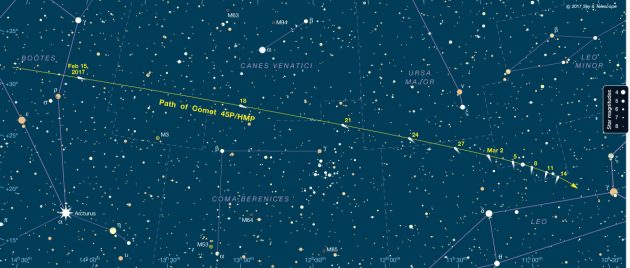
Sky & Telescope diagram
The situation improves dramatically in early February when 45P/H-M-P picks up apparent speed as it zooms by Earth, bounding from Aquila in the morning sky to Coma Berenices in the evening in the span of just two weeks!
Update March 16, 2017: Use the finder chart for Comet T-G-K here (the ticks are for 9 p.m. EDT = 1h UT on the following date). The earlier charts that appeared with this article, which are also printed in the May 2017 Sky & Telescope, are significantly off due to a change in the ephemeris.
About the time 45P/H-M-P rounds the corner from Coma into Leo and slows down, 41P/T-G-K heats up. Expect it to brighten to magnitude +12 in late February while moving north along the border between Leo and Cancer in the evening sky. Keeping pace with the seasonal constellations from winter through early summer, the comet will be well placed throughout its apparition. Come early April, it may reach magnitude +6 and become faintly visible with the naked eye as it crosses from the Big Dipper into Draco.
After these two flybys, we'll have to sit tight for the grand finale, when 46P/Wirtanen cracks the 12th-magnitude barrier in early October 2018. Like 45P/H-M-P, it should quickly brighten, catapulting to the top of its light curve in mid-December at 4th magnitude — an easy catch for naked-eye observers under reasonably dark skies. At that time, 46P/Wirtanen will be winging its way northward across Taurus and Auriga and beautifully placed for viewing.
Comets are notorious for both surprise outbursts in brightness and not living up to expectations. The peak magnitudes just described come from light curves provided by Seiichi Yoshida on his Visual Comets of the Future page. Predictions are decidedly more conservative on the JPL Horizons site where 45P/H-M-P peaks at magnitude +6, 41P/T-G-K at +8, and 46P/Wirtanen at +7.5. But no matter which light curve you lean on, all three should be easy binocular comets and reveal lots of coma details to imagers.
To participate in the campaign, click here for complete details.
 7
7








Comments
David57
December 1, 2016 at 5:03 pm
Am I correct that I should be able to image this comet with my C11/CGE, using my Nikon 5200 at prime focus?
You must be logged in to post a comment.
Bob KingPost Author
December 1, 2016 at 7:21 pm
Hi David,
The campaign is specifically interested in the coma and near-nucleus region in each of the three comets. Your C-11 should be more than up to the task.
You must be logged in to post a comment.
Anthony Barreiro
December 2, 2016 at 4:02 pm
Thanks Bob. Even if I'm not contributing to science, I hope to see the faint glow of one or more of these comets through binoculars or a small telescope, through urban light pollution if possible, or perhaps a field trip to get out under a dark sky. The finder charts are very helpful. On the chart for 45P from February 15 to 24, the comet moves quite a bit between three-day ticks. Will linear interpolation work well enough to get the comet in a binocular field?
You must be logged in to post a comment.
December 2, 2016 at 4:51 pm
Bob, I'll be pleased to try to find 45P/H-M-P using my C8 from Borrego Springs (probably a challenge!) but I was curious -- will 45P/H-M-P be visible between mid-January and mid-February? The charts provided don't seem to show locations during that time. If so, then I'd want to start looking around the end of January (new moon is Jan 28). By mid-Feb, I'm guessing moonlight will be a significant issue for imaging Comet 45P/H-M-P. Please redirect me if I have something wrong. Thanks! David
You must be logged in to post a comment.
Bob KingPost Author
December 3, 2016 at 10:38 am
Hi David,
That interval is missing in part because the comet will be very near the sun during that time (especially late Jan.) and not visible. However, it should still be visible very low in the evening sky around the 20th of January and reappear in the morning sky at the onset of dawn in early February. I will work post a fresh chart around that time so observers like yourself can follow it on as many days as possible. Thank you for your comment.
You must be logged in to post a comment.
FelicianoC
December 10, 2016 at 4:26 pm
Thank you Bob for including PACA in your article! I have enjoyed participating in all the previous comet campaigns so I am looking forward to what these next campaigns and comets will bring.
Christina Feliciano - Slooh Campaign PI
You must be logged in to post a comment.
Bob KingPost Author
December 11, 2016 at 12:59 am
Feliciano,
PACA is a wonderful organization, and it's great that you plan to participate in it once again. I like that they provide an outlet for those making visual and other observations of the three comets, a perfect complement to the 4*P Campaign.
You must be logged in to post a comment.
You must be logged in to post a comment.